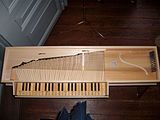Organeum
The Organeum in Weener is a cultural and educational center with a museum for keyboard instruments .
Story and concept
The representative villa of the Organeum was designed by the architect Stüve in 1870–1873 and built by Jan Hesse. Stylistically, the building combines elements of the English neo-Gothic , the Dutch town house and the ancient atrium into a closed whole, following the principle of eclecticism . The upper-class city villa in the old town center of Weener, which served as a residential building for a long time, is located in the immediate vicinity of the historic Arp Schnitger organ from 1710. The city of Weener, as the owner, had the building restored in the 1990s. In 2012/2013 an exterior and interior renovation followed, which included a reconstruction of the balcony and winter garden.
The Organeum was founded in 1997 by Harald Vogel and serves to develop, research and promote the north-west German organ landscape. Winfried Dahlke has been the artistic director of the Organeum LKMD since 2002 . The Organeum is in the context of the East Frisian cultural area, with over 100 historical instruments from seven centuries one of the richest organ landscapes in the world. Initially an institution of the East Frisian Landscape , it has been supported since 2006 as ORGANEUM - Ostfriesische Orgelakademie by the Ostfrieslandstiftung der Ostfriesische Landschaft, the Georgskirche in Weener and the city of Weener. The organ center receives further support from the “Förderkreis Organeum in Weener eV”.
The instrument collection is integrated into an educational concept that aims to convey the sound, function and history of the old instruments to a wide audience and is designed to be interactive. Various transportable functional organ models, which are also demonstrated in schools, an exhibition on organ culture and the use of audiovisual media provide support. As an organ center, cultural center and organizational center, the Organeum organizes guided tours, concerts, master classes, advanced training courses, tourist excursions and offers space for a diverse range of cultural activities. A representative selection of organ sheet music can be viewed. An organological library is available for research purposes. As part of a research project by the Organeum, Winfried Dahlke and organ builder Jürgen Ahrend inventoried the inscriptions on the historic pipe work of the organ in the Great Church in Leer from 2006–2008 and documented the organ's history scientifically.
Instrument inventory (selection)
As a museum, the Organeum u. a. a collection of around 40 valuable historical keyboard instruments and replicas . It is supplemented by some suction wind harmonies .
| year | instrument | builder | image | Art | Remarks |
|---|---|---|---|---|---|
| 1741 | harpsichord | Christian Zell (Hamburg) |
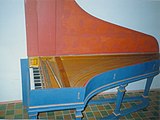
|
original | one-manual; built for the last East Frisian prince Carl Edzard ; one of the best preserved harpsichords of the German high baroque |
| 1790 | Cabinet organ | Ibe Peters Iben (Emden) |

|
original | with double doors; 5 registers ; Restored in 2007/2008 by Reinalt Johannes Klein |
| around 1796 | Bureaux organ | Frans Casper Snitger / Heinrich Hermann Freytag | original | 5 registers; built into a secretary | |
| around 1800 | Cabinet organ | Jan Jacob Vool (Netherlands) |

|
original | 6 registers in bass, 8 in treble |
| 1822 | Square piano | Johann Peter Hinrichs (Hamburg) |
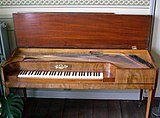
|
original | with simple push mechanism |
| around 1825 | Square piano | Ludwig Kulmbach (Heilbronn) |

|
original | 2013 restoration by Bartelt Immer |
| around 1830 | Physharmonica | unknown builder |
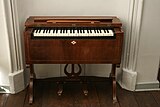
|
original | Forerunner of the later harmonium with an 8 ′; Loan from Winfried Dahlke |
| Mid 19th century | Square piano | Knake Brothers (Münster) |
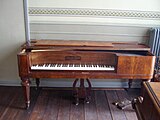
|
original | with metal frame; Permanent loan from the Weener local history museum |
| 19th century | Pressure wind harmonium | Wilhelm Rudolph (Giessen) |

|
original | two-way |
| 1867 | Pressure wind harmonium | Alexandre-François Debain (Paris) |

|
original | an 8 'register |
| 2nd half of the 19th century | Pressure wind harmonium | Schiedmayer Company (Stuttgart) |

|
original | two-manual; Loan from Winfried Dahlke |
| 1881 | Artificial harmonium | Victor Mustel (Paris) | original | 5 bass and 7 treble registers; Loan from Winfried Dahlke | |
| around 1888 | wing | John Broadwood & Sons (London) |
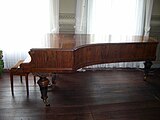
|
original | Rosewood veneer |
| 19th century | Pressure wind harmonium | Wilhelm Emmer (Berlin) | original | two games in 8 ′ and 4 ′ | |
| 19./20. Century | Pressure wind harmonium | GF Steinmeyer & Co. | original | unrestored | |
| 19./20. Century | Pressure wind harmonium | Gustav Steinmann organ building |

|
original | rebuilt in the 20th century |
| around 1900 | Pressure wind harmonium | Schiedmayer Company (Stuttgart) | original | Loan from Winfried Dahlke | |
| around 1920 | Pedal piano | Berdux (Munich) |
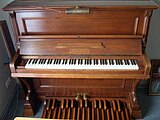
|
original | with full pedal keyboard, which is coupled an octave lower (corresponding to the 16 feet on the organ); On permanent loan from the Janse-Balzer family |
| 1st half of the 20th century | Pedal harmonium | Theodor Mannborg (Leipzig) |
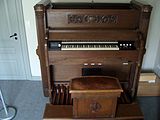
|
original | with full pedal keyboard |
| 1st half of the 20th century | Case harmonium | "Voorheen Jac. van Breemen Aalsmeer organ-piano-en radio trade " | original | 8 ′ register with 3 manubria | |
| 1966 | harpsichord | Klaus Ahrend |

|
Replica | two-manual, after Dulcken |
| 1969 | harpsichord | Klaus Ahrend |

|
Replica | based on the Italian model |
| 1976 | harpsichord | Keith Hill |
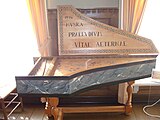
|
Replica | after a Flemish Ruckers -Cembalo (17th century) with a short octave , on loan from Harald Vogel |
| 1977 | Clavichord | Keith Hill |
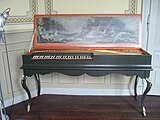
|
based on models | after Johann Adolph Hass (Hamburg, 1740) |
| 1979 | harpsichord | Martin Sassmann |
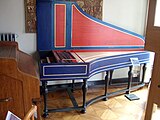
|
Copy | two-manual, after Christian Zell (Hamburg, 1728) |
| 1983 | Harpsichord universale ( Cimbalo cromatico ) | Keith Hill |

|
reconstruction | with 19 keys per octave (divided upper keys as subsemitonies ) according to the description by Michael Praetorius (1619)
|
| 1983 | Organ shelf | Engelke Brink |

|
Kit instrument with its own tongues | Production of the tongues with the advice of Jürgen Ahrend |
| 1990 | House organ | Jürgen Ahrend | original | two-manual, 11 stops with pedals in the baroque style; originally privately owned in Celle | |
| 1994 | Canopy organ | Jürgen Ahrend | Replica of a Renaissance organ (1559) after Michael Strobl on the Churburg for Count Trapp | single manual, 6 registers; Permanent loan from the EKHN | |
| 2007 | Clavichord | Matthias Griewisch | reconstruction | Replica of a bound clavichord after Michael Praetorius : Syntagma musicum (1619) | |
| 2007 | Organ function model | Harm Dieder Kirschner | model | ||
| 2010 | Organ function model | Winold van der Putten | model | "Organ for the classroom" | |
| 2012 | Clavichord | Gregor Bergmann | Replica | after Christian Gottlob Hubert (Ansbach, 1789) | |
| 2016 | Organ function model | Gregor Bergmann | model | "Suitcase organ" |
literature
- Winfried Dahlke, Günter GA Marklein: Organeum. Organ Academy Ostfriesland . Isensee, Oldenburg 2016, ISBN 978-3-7308-1320-1 .
Web links
- Organeum (with photos, audio samples and descriptions of the instruments)
- orgel.edskes.net: Photos by W. Dahlke
Individual evidence
- ^ Dahlke, Marklein: Organeum. 2016, pp. 7–9.
- ↑ Jürgen Ahrend, Winfried Dahlke: Documentation of the organ of the Evangelical Reformed Church in Leer . Print-on-demand, without location 2008.
- ^ Michael Praetorius: Syntagma musicum. Vol. 2: De Organographia (1619). Reprint: Bärenreiter, Kassel 2001, ISBN 978-3-7618-1527-4 , pp. 63-66 ( online , accessed July 14, 2017).
- ↑ Photos on flickr , viewed January 12, 2012.
Coordinates: 53 ° 9 ′ 58.7 ″ N , 7 ° 21 ′ 20.5 ″ E





